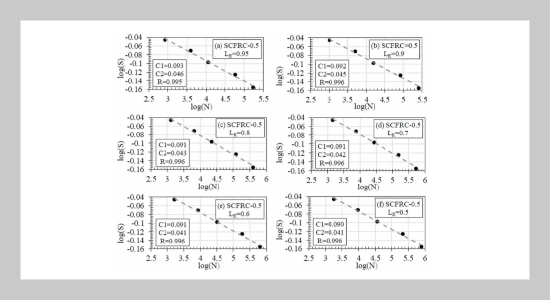REFERENCES
- [1] Moya, J., Pardo, N. and Mercier, A., Energy Efficiency and CO2 Emissions: Prospective Scenarios for the Cement Industry, Publications Office (2010).
- [2] Celik, K., Meral, C., Gursel, A. P., Mehta, P. K, Horvath, A. and Monteiro, P. J., “Mechanical Properties, Durability, and Life-cycle Assessment of Self-consolidating Concrete Mixtures Made with Blended Portland Cements Containing Fly Ash and Limestone Powder,” Cem. Concr. Comp., Vol. 56, pp. 59–72 (2015). doi:10.1016/j.cemconcomp.2014.11.003
- [3] Esquinas, A. R., Ramos, C., Jiménez, J. R., Fernández, J. M. and Brito, J., “Mechanical Behaviour of Self compacting Concrete Made with Recovery Filler from Hot-mix Asphalt Plants,” Constr. Build. Mater., Vol.131, pp. 114–128 (2017). doi: 10.1016/j.conbuildmat.2016.11.063
- [4] Hwang, S. D. and Khayat, K., “Durability Characteristics of Self-consolidating Concrete Designated for Repair Applications,” Mater. Struct�, Vol. 42, No. 1, pp.1–14 (2009). doi: 10.1617/s11527-008-9362-1
- [5] Hossain, K. M. A. and Lachemi, M., “Fresh, Mechanical, and Durability Characteristics of Self-consolidating Concrete Incorporating Volcanic Ash,” ASCE J. Mater.CivilEng.,Vol.22, No. 7,pp. 651–657 (2010).
- [6] Cattaneo, S., Giussani, F. and Mola, F., “Flexural Behaviour of Reinforced, Prestressed and Composite Self consolidating Concrete Beams,”Constr. Build. Mater., Vol. 36, No. 11, pp. 826–837 (2012). doi: 10.1016/j.conbuildmat.2012.06.001
- [7] Ambroise, J., Rols, S. and Pera, J., “Properties of Self leveling Concrete Reinforced by Steel Fibres,” Proceedings of 43rd Brazilian Congress of the Concrete (IBRACON), Brazil; August (2001).
- [8] Salehian, H. and Barro, J. A. O., “Assessment of the Performance of Steel Fibre Reinforced Self-compacting Concrete in Elevated Slabs,” Cem. Concr. Comp., Vol. 55, pp. 268–280 (2015). doi: 10.1016/j.cemconcomp.2014.09.016
- [9] Lameiras, R., Barros, J. A. O. and Azenha, M., “Influence of Casting Condition on the Anisotropy of the Fracture Properties of Steel Fibre Reinforced Self-compacting Concrete (SFRSCC),” Cem. Concr. Comp., Vol.59, pp. 60�76 (2015). doi: 10.1016/j.cemconcomp.2015.03.008
- [10] Singh, S. P. and Kaushik, S. K., “Flexural Fatigue Analysis of Steel Fibre Reinforced Concrete,” ACI Mater. J., Vol. 98, No. 4, pp. 306–312 (2001).
- [11] Singh, S. P., Mohammadi, Y., Goel, S. and Kaushik, S. K., “Prediction of Mean and Design Fatigue Lives of Steel Fibrous Concrete Beamsin Flexure,” Adv. Struct. Eng., Vol. 10, No. 1, pp. 25–36 (2007).
- [12] ACI Committee 215, “Consideration for Design of Concrete Structures Subjected to Fatigue Loading,” ACI Manual of Concrete Practice, Part 1, 215R–1215R–25 (1990).
- [13] Arora, S. and Singh, S. P., “Analysis of Flexural Fatigue Failure of Concrete Made with 100% Coarse Recycled Concrete Aggregates,”Constr.Build.Mater.,Vol.102, pp. 782–791 (2016). doi: 10.1016/j.conbuildmat.2015.10.098
- [14] Selmy, A. I., Azab, N. A. and Abd El-Baky, M. A., “Flexural Fatigue Characteristics of Two Different Types of Glass Fiber/epoxy Polymeric Composite Laminates with Statistical Analysis,” Composites Part B, Vol. 45, pp. 518–527 (2013). doi: 10.1016/j.compositesb.2012.08.017
- [15] Zhou, J., Zheng, M., Wang, Q., Yang, J. and Lin T., “Flexural Fatigue Behavior of Polymer-modified Pervious Concrete with Single Sized Aggregates,” Constr. Build. Mater., Vol. 124, pp. 897–905 (2016). doi: 10.1016/j.conbuildmat.2016.07.136
- [16] Li, Q., Huang, B., Xu, S., Zhoua, B. and Yu, R. C., “Compressive Fatigue Damage and Failure Mechanism of Fiber Reinforced Cementitious Material with High Ductility,” Cem. Concr. Res., Vol. 90, pp. 174–183 (2016). doi: 10.1016/j.cemconres.2016.09.019
- [17] Lee,J., Harris, B.,Almond,D. P.and Hammett,F., “Fibre Composite Fatigue Life Determination,” Composites A, Vol. 28, pp. 5–15 (1997). doi: 10.1016/S1359835X(96)00088-7
- [18] Li, H., Zhang, M. and Ou, J., “Flexural Fatigue Performance of Concrete Containing Nano-particles for Pavement,” Int. J. Fatig., Vol. 29, pp. 1292–1301 (2007). doi: 10.1016/j.ijfatigue.2006.10.004
- [19] Jang, J. G., Kim, H. K., Kim, T. S., Min, B. J. and Lee, H. K., “Improved Flexural Fatigue Resistance of PVA Fiber-reinforced Concrete Subjected to Freezing and Thawing Cycles,” Constr. Build. Mater., Vol. 59, pp. 129�135 (2014). doi: 10.1016/j.conbuildmat.2014.02.040
- [20] Goel, S., Singh, S. P. and Singh, P., “Flexural Fatigue Strength and Failure Probability of Self Compacting Fibre Reinforced Concrete Beams,” Eng. Struct., Vol.40, pp. 131–140 (2012). doi: 10.1016/j.engstruct.2012.02.035
- [21] Kaitai, F. and Jianlun, X., Statistical Distribution, Beijing, Science Press (1987). (in Chinese)
- [22] Zhentong, G., Fatigue Application Statistics, Beijing, National Defence Industry Press (1986). (in Chinese)
- [23] Ganesan, N., Bharatiaj, J. and Shashikala, A. P., “Flexural Fatigue Behavior of Self-compacting Rubberized Concrete,” Constr. Build. Mater., Vol. 44, pp. 7–14 (2013). doi: 10.1016/j.conbuildmat.2013.02.077
- [24] Fothergill, J. C., “Estimatingthe Cumulative Probability of Failure Data Points to be Plotted on Weibull and Other Probability Paper,” IEEE Trans. Elect. Insul., Vol. 25, No. 3, pp. 489�492 (1990).
- [25] Skinner, K. R., Keats, J. B. and Zimmer, W. J., “A Comparison of Three Estimators of the Weibull Parameters,”QualRelia.EngInter.,Vol.17,No.4,pp.249� 256 (2001).
- [26] Bernard, A. and Bosi, L. E. C., “The Plotting of Observations on Probability Paper,” Stat. Neerlandica, Vol. 53, No. 7, pp. 163�173 (1953).
- [27] Akdag, S. A. and Dinler, A., “A New Method to Estimate Weibull Parameters for Wind Energy Applications, Energy,” Convers. Manage, Vol. 50, pp. 1761–1766 (2009). doi: 10.1016/j.enconman.2009.03.020
- [28] Rocha, P. A. C., Sousa, R. C., Andrade, C. F. and Vieira Da Silva, M. E. “Comparison of Seven Numerical Methods for Determining Weibull Parameters for Wind Energy Generation in the Northeast Region of Brazil,” Appl. Energy, Vol. 89, pp. 395–400 (2012). doi: 10.1016/j.apenergy.2011.08.003
- [29] Prashanth Kumar, K. S. and Gaddada, S., “Statistical Scrutiny of Weibull Parameters for Wind Energy Potential Appraisal in the Area of Northern Ethiopia,” Renewables, Vol. 2, No. 14, pp. 1�15 (2015). doi: 10.1186/s40807-015-0014-0
- [30] Sun, J., Yu, J. M. and Zhao, H. S., “Two-parameter Weibull Distribution Theory Testing in Fatigue Life of Asphalt Mixture,” App. Mech. Mate. Adv. Transp., Vol.45, No. 8, pp. 97–98 (2011).
















